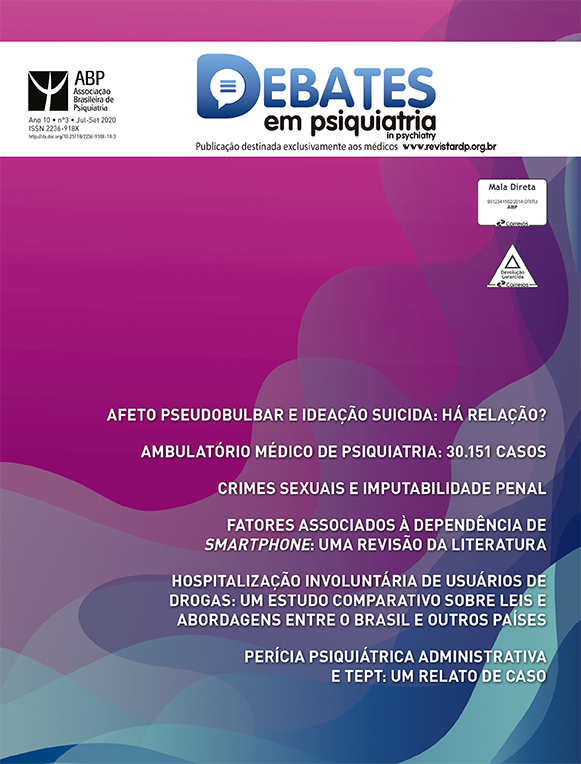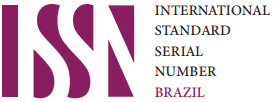Fatores associados à dependência de smartphone: uma revisão da literatura
DOI:
https://doi.org/10.25118/2763-9037.2020.v10.27Palavras-chave:
Dependência de smartphone, dependências tecnológicas, dependências comportamentaisResumo
Conhecer melhor o que se chama de dependência de smartphone (DS) é importante para a prática clínica. Nos últimos 10 anos, um corpo de evidências clínicas e epidemiológicas foi produzido em vários países. Esses estudos apontam fatores sociodemográficos, hábitos de vida, transtornos psiquiátricos e traços de personalidade associados à DS. Contudo, não há estudos de revisão que sintetizem os resultados. Objetivamos revisar a literatura sobre os fatores associados à DS. Foi realizada uma revisão bibliográfica sistemática nas bases de dados PubMed e SciELO. Restringimos a busca aos artigos publicados nos últimos 10 anos. Excluímos revisões de literatura, estudos pré-clínicos e opiniões de especialistas. Na fase final, selecionamos 42 artigos. Os fatores sociodemográficos associados à DS foram sexo feminino, idade entre 18 e 25 anos e alta renda familiar. Os hábitos de vida foram cronótipo noturno, baixa atividade física e sedentarismo. Os conteúdos mais associados à DS foram as redes sociais. As síndromes de dependência mais associadas à DS foram as relacionadas ao álcool e tecnológicas. Os transtornos e/ou sintomas psiquiátricos associados foram os transtornos depressivos e ansiosos, o estresse e a insônia. Por fim, os traços de personalidade associados foram alta impulsividade, alta agressividade, baixa autoestima, personalidade do tipo A e personalidade multitarefa. Existe um corpo de evidências que mostra semelhanças entre os achados epidemiológicos encontrados para a DS e para outras formas de dependência. Mais estudos são necessários para aprofundar o nosso conhecimento sobre esse tema.
Downloads
Métricas
Referências
Head M, Ziolkowski N. Understanding student attitudes of mobile phone features: rethinking adoption through conjoint, cluster and SEM analyses. Comput Human Behav. 2012;28:2331-9.
Shambare R, Rugimbana R, Zhowa T. Are mobile phones the 21st century addiction? Afri J Bus Manage. 2012;6:573-7.
Al-Barashdi HS, Bouazza A, Jabur NH. Smartphone addiction among university undergraduates: a literature review. J Sci Res Rep. 2015;4:210-25.
Kubey RW, Lavin MJ, Barrows JR. Internet use and collegiate academic performance decrements: early findings. J Commun. 2001;51:366-82.
Palen L, Salzman M, Youngs E. Discovery and integration of mobile communications in everyday life. Pers Ubiquitous Comput. 2001;5:109-22.
Lee KC, Perry SD. Student instant message use in a ubiquitous computing environment: effects of deficient self-regulation. J Broadcast Electron Media. 2004;48:399-420.
Klauer S, Guo F, Simons-Morton B, Ouimet MC. Distracted driving and risk of road crashes among novice and experienced drivers. N Engl J Med. 2014;370:54-9.
Ahmed I, Qazi TF, Perji KA. Mobile phone to youngsters: necessity or addiction. Afri J Bus Manage. 2011;5:12512-9.
Choi J, Rho MJ, Kim Y, Yook IH, Yu H, Kim DJ, et al. Smartphone dependence classification using tensor factorization. PLoS One. 2017;12:e0177629.
Choi SW, Kim DJ, Choi JS, Ahn H, Choi EJ, Song WY, et al. Comparison of risk and protective factors associated with smartphone addiction and Internet addiction. J Behav Addict. 2015;4:308-14.
Chóliz M. Mobile phone addiction: a point of issue. Addiction. 2010;105:373-4.
Kwon M, Lee JY, Won WY, Park JW, Min JA, Hahn C, et al. Development and validation of a smartphone addiction scale (SAS). PloS One. 2013;8:e56936.
Billieux J, Maurage P, Lopez-Fernandez O, Kuss DJ, Griffiths MD. Can disordered mobile phone use be considered a behavioral addiction? An update on current evidence and a comprehensive model for future research. Curr Addict Rep. 2015;2:156-62.
de Oliveira AFP. Neurobiologia dos comportamentos aditivos [thesis]. Porto: Universidade do Porto; 2012.
Goodman A. Addiction: definition and implications. Br J Addict. 1990;85:1403-8.
Randler C, Wolfgang L, Matt K, Demirhan E, Horzum MB, Beşoluk S. Smartphone addiction proneness in relation to sleep and morningnesseveningness in German adolescents. J Behav Addict. 2016;5:465-73.
Kim SE, Kim JW, Jee YS. Relationship between smartphone addiction and physical activity in Chinese international students in Korea. J Behav Addict. 2015;4:200-5.
Demirci K, Akgonul M, Akpinar A. Relationship of smartphone use severity with sleep quality, depression, and anxiety in university students. J Behav Addict. 2015;4:85-92.
Mok JY, Choi SW, Kim DJ, Choi JS, Lee J, Ahn H, et al. Latent class analysis on internet and smartphone addiction in college students. Neuropsychiatr Dis Treat. 2014;10:817-28.
Augner C, Hacker GW. Associations between problematic mobile phone use and psychological parameters in young adults. Int J Public Health. 2012;57:437-41.
Takao M, Takahashi S, Kitamura M. Addictive personality and problematic mobile phone use. Cyberpsychol Behav. 2009;12:501-7.
Leung L. Linking psychological attributes to addiction and improper use of the mobile phone among adolescents in Hong Kong. J Child Media. 2008;2:93-113.
Jenaro C, Flores N, Gómez-Vela M, González-Gil F, Caballo C. Problematic internet and cellphone use: psychological, bahavioral, and health correlates. Addict Res Theory. 2007;15:309-20.
Beison A, Rademacher DJ. Relationship between family history of alcohol addiction, parents’ education level, and smartphone problem use scale scores. J Behav Addict. 2017;6:84-91.
Long J, Liu TQ, Liao YH, Qi C, He HY, Chen SB, et al. Prevalence and correlates of problematic smartphone use in a large random sample of Chinese undergraduates. BMC Psychiatry. 2016;16:408.
Lee KE, Kim SH, Ha TY, Yoo YM, Han JJ, Jung JH, et al. Dependency on smartphone use and its association with anxiety in Korea. Public Health Rep. 2016;131:411-9.
Hong FY, Chiu SI, Huang DH. A model of the relationship between psychological characteristics, mobile phone addiction and use of mobile phones by Taiwanese university female students. Comput Human Behav. 2012;28:2152-9.
Kim Y, Jeong JE, Cho H, Jung DJ, Kwak M, Rho MJ, et al. Personality factors predicting smartphone addiction predisposition: behavioral inhibition and activation systems, impulsivity, and self-control. PLoS One. 2016;11:e0159788.
Smetaniuk P. A preliminary investigation into the prevalence and prediction of problematic cell phone use. J Behav Addict. 2014;3:41-53.
Wu AM, Cheung VI, Ku L, Hung EP. Psychological risk factors of addiction to social networking sites among Chinese smartphone users. J Behav Addict. 2013;2:160-6.
Billieux J, Van der Linden M, d‘Acremont M, Ceschi G, Zermatten A. Does impulsivity relate to perceived dependence on and actual use of the mobile phone? Appl Cogn Psychol. 2007;21:527-37.
Billieux J, Van der Linden M, Rochat L. The role of impulsivity in actual and problematic use of the mobile phone. Appl Cogn Psychol. 2008;22:1195-210.
Matar Boumosleh J, Jaalouk D. Depression, anxiety, and smartphone addiction in university students- a cross sectional study. PLoS One. 2017;12:e0182239.
Oberst U, Wegmann E, Stodt B, Brand M, Chamarro A. Negative consequences from heavy social networking in adolescents: the mediating role of fear of missing out. J Adolesc. 2017;55:51-60.
Randler C, Wolfgang L, Matt K, Demirhan E, Horzum MB, Beşoluk S. Smartphone addiction proneness in relation to sleep and morningnesseveningness in German adolescents. J Behav Addict. 2016;5:465-73.
Alosaimi FD, Alyahya H, Alshahwan H, Al Mahyijari N, Shaik SA. Smartphone addiction among university students in Riyadh, Saudi Arabia. Saudi Med J. 2016;37:675-83.
Darcin AE, Kose S, Noyan CO, Nurmedov S, Yılmaz O, Dilbaz N. Smartphone addiction and its relationship with social anxiety and loneliness. Behav Inf Technol. 2016;35:520-5.
Haug S, Castro RP, Kwon M, Filler A, Kowatsch T, Schaub MP. Smartphone use and smartphone addiction among young people in Switzerland. J Behav Addict. 2015;4:299-307.
Toda M, Nishio N, Takeshita T. Predictive factors for smartphone dependence: relationship to demographic characteristics, chronotype, and depressive state of university students. Open J Prev Med. 2015;5:456-62.
Wang JL, Wang HZ, Gaskin J, Wang LH. The role of stress and motivation in problematic smartphone use among college students. Comput Human Behav. 2015;53:181-8.
Lin YH, Lin YC, Lee YH, Lin PH, Lin SH, Chang LR, et al. Time distortion associated with smartphone addiction: identifying smartphone addiction via a mobile application (App). J Psychiatr Res. 2015;65:139-45.
Bian M, Leung L. Smartphone addiction: linking loneliness, shyness, symptoms and patterns of use to social capital. Media Asia. 2014;41:159-76.
Lee EB. Too much information: heavy smartphone and Facebook utilization by African American young adults. J Black Stud. 2015;46:44-61.
Chiu SI. The relationship between life stress and smartphone addiction on Taiwanese university student: a mediation model of learning selfefficacy and social self-efficacy. Comput Human Behav. 2014;34:49-57.
Harwood J, Dooley JJ, Scott AJ, Joiner R. Constantly connected–the effects of smartdevices on mental health. Comput Human Behav. 2014;34:267-72.
Lee YK, Chang CT, Lin Y, Cheng ZH. The dark side of smartphone usage: psychological traits, compulsive behavior and technostress. Comput Human Behav. 2014;31:373-83.
Cagan O, Unsal A, Celik N. Evaluation of college students’ level of addiction to cellular phone and investigation on the relationship between the addiction and the level of depression. Procedia Soc Behav Sci. 2014;114:831-9.
Zheng F, Gao P, He M, Li M, Wang C, Zeng Q, et al. Association between mobile phone use and inattention in 7102 Chinese adolescents: a population-based cross-sectional study. BMC Public Health. 2014;14:1022.
Roberts JA, Yaya LH, Manolis C. The invisible addiction: cell-phone activities and addiction among male and female college students. J Behav Addict. 2014;3:254-65.
Sahin S, Ozdemir K, Unsal A, Temiz N. Evaluation of mobile phone addiction level and sleep quality in university students. Pak J Med Sci. 2013;29:913-8.
Lu X, Watanabe J, Liu Q, Uji M, Shono M, Kitamura T. Internet and mobile phone text-messaging dependency: factor structure and correlation with dysphoric mood among Japanese adults. Comput Human Behav. 2011;27:1702-9.
Walsh SP, White KM, Cox S, McD Young R. Keeping in constant touch: the predictors of young Australians’ mobile phone involvement. Comput Human Behav. 2011;27:333-42.
Yang YS, Yen JY, Ko CH, Cheng CP, Yen CF. The association between problematic cellular phone use and risky behaviors and low self-esteem among Taiwanese adolescents. BMC Public Health. 2010;10:217.
Zulkefly SN, Baharudin R. Mobile phone use amongst students in a university in Malaysia: its correlates and relationship to psychological health. Eur J Sci Res. 2009;37:206-18.
Yen CF, Tang TC, Yen JY, Lin HC, Huang CF, Liu SC, et al. Symptoms of problematic cellular phone use, functional impairment and its association with depression among adolescents in Southern Taiwan. J Adolesc. 2009;32:863-73.56. Bianchi A, Phillips JG. Psychological predictors of problem mobile phone use. Cyberpsychol Behav. 2005;8:39-51.
Toda M, Monden K, Kubo K, Morimoto K. Mobile phone dependence and health-related lifestyle of university students. Soc Behav Pers. 2006;34:1277-84.
da Luz FQ, Sainsbury A, Mannan H, Touyz S, Mitchison D, Girosi F, et al. An investigation of relationships between disordered eating behaviors, weight/shape overvaluation and mood in the general population. Appetite. 2018;129:19-24.
Hong FY, Huang DH, Lin DY, Chiu SL. Analysis of the psychological traits, Facebook usage, and Facebook addiction model of Taiwanese university students. Telematics Inform. 2014;31:597-606.
Lee H, Kim JW, Choi TY. Risk factors for smartphone addiction in Korean adolescents: smartphone use patterns. J Korean Med Sci. 2017;32:1674-9.
Martinotti G, Villella C, Di Thiene D, Di Nicola M, Bria P, Conte G, et al. Problematic mobile phone use in adolescence: a cross sectional study. J Public Health. 2011;19:545-51.
Abojedy A. Mobile phone addiction and its relationship with self-discloser among sample of students from University of Jordan and Amman Al-Ahliyya University. Jordan J Educ Sci. 2008;4:137-50.
Devis-Devis J, Peiró-Velert C, Beltrán-Carrillo VJ, Tomás JM. Screen media time usage of 12-16 year-old Spanish school adolescents: effects of personal and socioeconomic factors, season and type of day. J Adolesc. 2009;32:213-31.
Chóliz M. Mobile-phone addiction in adolescence: the test of mobile phone dependence (TMD). Prog Health Sci. 2012;2:33-44.
Sánchez-Martínez M, Otero A. Factors associated with cell phone use in adolescents in the community of Madrid (Spain). Cyberpsychol Behav. 2009;12:131-7.
Kawasaki N, Tanei S, Ogata F, Burapadaja S, Loetkham C, Nakamura T, et al. Survey on cellular phone usage on students in Thailand. J Physiol Anthropol. 2006;25:377-82.
Chung N. Korean adolescent girls’ addictive use of mobile phones to maintain interpersonal solidarity. Soc Behav Pers. 2011;39:1349-58.
Hakoama M, Hakoyama S. The impact of cell phone use on social networking and development among college students. AABSS J. 2011;15:1-20.
Igarashi T, Motoyoshi T, Takai J, Yoshida T. No mobile, no life: self-perception and text-message dependency among Japanese high school students. Comput Human Behav. 2008;24:2311-24.
Weiser EB. Gender differences in Internet use patterns and Internet application preferences: a two-sample comparison. Cyberpsychol Behav. 2000;3:167-77.
Heo J, Oh J, Subramanian SV, Kim Y, Kawachi I. Addictive internet use among Korean adolescents: a national survey. PloS One. 2014;9:e87819.
Jeong SH, Kim H, Yum JY, Hwang Y. What type of content are smartphone users addicted to? SNS vs. games. Comput Human Behav. 2016;54:10-7.
Kneer J, Glock S. Escaping in digital games: the relationship between playing motives and addictive tendencies in males. Comput Human Behav. 2013;29:1415-20.
Milosevic J, Žeželj I. Psychological predictors of addictive social networking sites use: the case of Serbia. Comput Human Behav. 2014;32:229-34.
Fattore L, Melis M, Fadda P, Fratta W. Sex differences in addictive disorders. Front Neuroendocrinol. 2014;35:272-84.
Cooper A, Morahan-Martin J, Mathy RM, Maheu M. Toward an increased understanding of user demographics in online sexual activities. J Sex Marital Ther. 2002;28:105-29.
Johansson A, Götestam KG. Internet addiction: characteristics of a questionnaire and prevalence in Norwegian youth (12-18 years). Scand J Psychol. 2004;45:223-9.
Nolen-Hoeksema S. Gender differences in depression. Curr Dir Psychol Sci. 2001;10:173-6.
Taylor M, Jinabhai CC, Naidoo K, Kleinschmidt I, Dlamini SB. An epidemiological perspective of substance use among high school pupils in rural KwaZulu-Natal S Afr Med J. 2003;93:136-40.
Bechara A, Dolan S, Denburg N, Hindes A, Anderson SW, Nathan PE. Decision-making deficits, linked to a dysfunctional ventromedial prefrontal cortex, revealed in alcohol and stimulant abusers. Neuropsychologia. 2001;39:376-89.
Bowden-Jones H, McPhillips M, Rogers R, Hutton S, Joyce E. Risk-taking on tests sensitive to ventromedial prefrontal cortex dysfunction predicts early relapse in alcohol dependency: a pilot study. J Neuropsychiatry Clin Neurosci. 2005;17:417-20.
Damasio AR. The somatic marker hypothesis and the possible functions of the prefrontal cortex. Philos Trans R Soc Lond B Biol Sci. 1996;351:1413-20.
Kim HJ, Min JY, Kim HJ, Min KB. Association between psychological and self-assessed health status and smartphone overuse among Korean college students. J Ment Health. 2019;28:11-6.
Prezza M, Pacilli MG, Dinelli S. Loneliness and new technologies in a group of Roman students. Comput Human Behav. 2004;20:691-709.
Castells M, Fernandez-Ardevol M, Qiu JL, Sey A. The mobile communication society: a crosscultural analysis of available evidence on the social uses of wireless communication technology [Interntet]. 2004 Oct [cited 2020 Aug 28]. citeseerx.ist.psu.edu/viewdoc/download?doi=10.1.1.109.3872&rep=rep1&type=pdf
Holden C. ‘Behavioral’ addictions: do they exist? Science. 2001;294:980-2.
Brewer JA, Potenza MN. The neurobiology and genetics of impulse control disorders: relationships to drug addictions. Biochem Pharmacol. 2008;75:63-75.
Wadsworth D, Gleason M, Stoner L. Can sedentary behaviour be considered a cultural maladaptation? Perspect Public Health. 2014;134:20-1.
Lin YH, Chang LR, Lee YH, Tseng HW, Kuo TB, Chen SH. Development and validation of the smartphone addiction inventory (SPAI). PLoS One. 2014;9:e98312.
O’Brien C. Addiction and dependence in DSM‐V. Addiction. 2011;106:866-7.
Associação Americana de Psiquiatria. Manual Diagnóstico e Estatístico de Transtornos Mentais, 5ª edição (DSM-5). Porto Alegre: Artmed; 2014.
Granda P, Jimena L. ¿Se constituye el uso del Smartphone en una adicción? [Internet]. 2013 [cited 2020 Aug 28]. pt.scribd.com/document/328955593/Se-Constituye-El-Uso-Del-Smartphone-en-Una-Adiccion
Koob GF, Volkow ND. Neurobiology of addiction: a neurocircuitry analysis. Lancet Psychiatry, 2016. 3(8): p. 760-73.
Holly EN, Boyson CO, Montagud-Romero S, Stein DJ, Gobrogge KL, DeBold JF, et al. Episodic social stress-escalated cocaine self-administration: role of phasic and tonic corticotropin releasing factor in the anterior and posterior ventral tegmental area. J Neurosci. 2016;36:4093-105.
Pascoli V, Terrier J, Hiver A, Lüscher C. Sufficiency of mesolimbic dopamine neuron stimulation for the progression to addiction. Neuron. 2015;88:1054-66.
Gawin FH. Cocaine addiction: psychology and neurophysiology. Science. 1991;251:1580-6.
Gold MS, Miller NS, Jonas JM. Cocaine (and crack): neurobiology. In: Lowinson JH, Ruiz P, Millman RB, Langrod JG, editors. Substance abuse: a comprehensive textbook. 2nd ed. Baltimore: Williams & Wilkins; 1992. p. 222-35.
Greenblatt DJ, Shader RI. Dependence, tolerance, and addiction to benzodiazepines: clinical and pharmacokinetic considerations. Drug Metab Rev. 1978;8:13-28
Smith DE, Wesson DR, Landry MJ. The pharmacology of benzodiazepine addiction. Fam Pract Recert. 1989;11(9 Suppl):94-107.
Ryan T, Chester A, Reece J, Xenos S. The uses and abuses of Facebook: a review of Facebook addiction. J Behav Addict. 2014;3:133-48.
Kuss DJ, Lopez-Fernandez O. Internet addiction and problematic Internet use: a systematic review of clinical research. World J Psychiatry. 2016;6:143-76.
Downloads
Publicado
Como Citar
Edição
Seção
Licença

Este trabalho está licenciado sob uma licença Creative Commons Attribution-NonCommercial 4.0 International License.
Debates em Psiquiatria permite que o (s) autor (es) mantenha(m) seus direitos autorais sem restrições. Atribuição-NãoComercial 4.0 Internacional (CC BY-NC 4.0) - Debates em Psiquiatria é regida pela licença CC-BY-NC
































